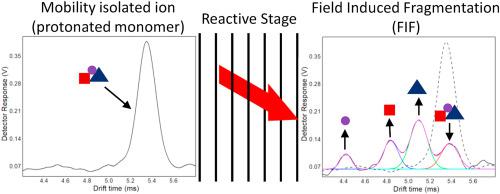International Journal of Mass Spectrometry ( IF 1.6 ) Pub Date : 2021-09-08 , DOI: 10.1016/j.ijms.2021.116701 Hossein Shokri 1 , Ben D. Gardner 1 , Peter E. Fowler 1 , Timotej Bernat 1 , John A. Stone 1 , Gary A. Eiceman 1

|
Field-induced fragmentation (FIF) spectra were obtained for mobility isolated protonated monomers of volatile organic compounds from six chemical families at 130 to 157 Td in the reactive stage of a tandem ion mobility spectrometer at 98 °C. The extent of fragmentation at ambient pressure increased linearly with field strength for n-alcohols of carbon number 3 to 5, for n-akyl acetates of carbon numbers 4 to 11, and for n-aldehydes and ethers not previously fragmented at 129 Td and 93 °C. Efficiencies of fragmentation at 157 Td ranged from 57 to 100% for n-alcohols, 25–100% for n-alkyl acetates of carbon numbers 5 to 8 (10–29% for carbon numbers 9 to 11), 29–84% for ethers of carbon numbers 8 and below, and 7–57% for n-alkanes of carbon numbers 7 to 11. Multiple, low mass ions in FIF spectra were attributed to second and third levels of fragmentation with identical reduced mobility coefficients characteristic of a chemical class. Differences in fragment ion patterns between chemical classes were attributed to structural information from field-induced fragmentation. Classification by chemical class using neural networks was significantly improved for acetates and aldehydes with increased fragmentation at 157 Td. Spectra without fragmentation were poorly classified. Models of ion energy within the reactive stage suggested that ions undergoing decomposition were not symmetrically distributed between etched metal grids in the reactive stage.
中文翻译:

环境压力下串联离子迁移谱的场致碎裂谱中的连续反应及其对神经网络分类的影响
在串联离子迁移率光谱仪的反应阶段,在 98 °C 下,在 130 至 157 Td 下,获得了来自六个化学家族的挥发性有机化合物的迁移分离质子化单体的场致碎裂 (FIF) 光谱。对于碳数为 3 到 5 的正醇、碳数为 4 到 11 的正烷基乙酸酯以及之前未在 129 Td 和 93 处碎裂的正醛和醚,在环境压力下的碎裂程度随场强线性增加℃。在 157 Td 时,正构醇的裂解效率为 57% 至 100%,碳数为 5 至 8 的乙酸正烷基酯为 25–100%(碳数为 9 至 11 为 10–29%),对于正构醇为 29–84%碳数为 8 及以下的醚,碳数为 7 至 11 的正烷烃为 7–57%。FIF 光谱中的低质量离子归因于具有相同化学类别特征的降低迁移率系数的第二级和第三级碎裂。化学类别之间碎片离子模式的差异归因于场诱导碎片的结构信息。使用神经网络按化学类别对乙酸酯和醛进行分类得到显着改善,在 157 Td 时碎片增加。没有碎片的光谱分类很差。反应阶段内的离子能量模型表明,在反应阶段中,经历分解的离子在蚀刻的金属网格之间不是对称分布的。化学类别之间碎片离子模式的差异归因于场诱导碎片的结构信息。使用神经网络按化学类别对乙酸酯和醛进行分类得到显着改善,在 157 Td 时碎片增加。没有碎片的光谱分类很差。反应阶段内的离子能量模型表明,在反应阶段中,经历分解的离子在蚀刻的金属网格之间不是对称分布的。化学类别之间碎片离子模式的差异归因于场诱导碎片的结构信息。使用神经网络按化学类别对乙酸酯和醛进行分类得到显着改善,在 157 Td 时碎片增加。没有碎片的光谱分类很差。反应阶段内的离子能量模型表明,在反应阶段中,经历分解的离子在蚀刻的金属网格之间不是对称分布的。











































 京公网安备 11010802027423号
京公网安备 11010802027423号